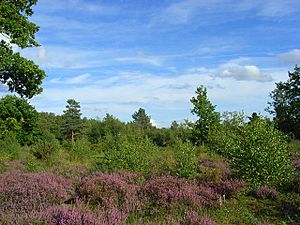Snelsmore Common facts for kids
| Site of Special Scientific Interest | |
 |
|
| Area of Search | Berkshire |
|---|---|
| Interest | Biological |
| Area | 104.0 hectares (257 acres) |
| Notification | 1989 |
| Location map | Magic Map |
Snelsmore Common is a special natural area located north of Newbury in Berkshire, England. It covers about 104 hectares (which is like 260 football fields!). This important place is owned by West Berkshire Council and looked after by the Berkshire, Buckinghamshire and Oxfordshire Wildlife Trust.
It's known as a biological Site of Special Scientific Interest (SSSI). This means it's a protected area because of its unique plants, animals, or geology. Snelsmore Common is protected because it's home to many different kinds of living things and habitats.
What Makes Snelsmore Common Special?
Snelsmore Common is a country park that has many different types of natural environments. These include:
- Dry heath: Areas with sandy soil and plants like heather that like dry conditions.
- Wet heath: Similar to dry heath but with more moisture, often found near bogs.
- Bog: A very wet, spongy area where special plants grow, and peat forms.
- Birch woods: Forests mainly made up of birch trees.
- Ancient semi-natural broadleaved woodland: Very old forests with a mix of trees that have been growing there for a long time.
Ancient Secrets in the Peat
One of the most interesting parts of Snelsmore Common is its bog. This bog holds a secret from the past: a layer of peat that is about 5,000 years old!
Scientists have studied this ancient peat. By looking at the different layers, they can learn about how the land was used thousands of years ago. They can also discover what kinds of plants grew there in the past. It's like reading a history book written by nature itself!
Tiny Plants: Lichens
In the wet alder woodland areas of Snelsmore Common, you can find many different types of lichens. Lichens are amazing living things that are actually a mix of a fungus and an alga growing together.
These lichens form a rich community, especially on the trees. Some of the lichens you might find here include Parmelia caperarta, Pertusaria pertusa, and Lecanactis abietina. They add to the unique biodiversity of this special common.

